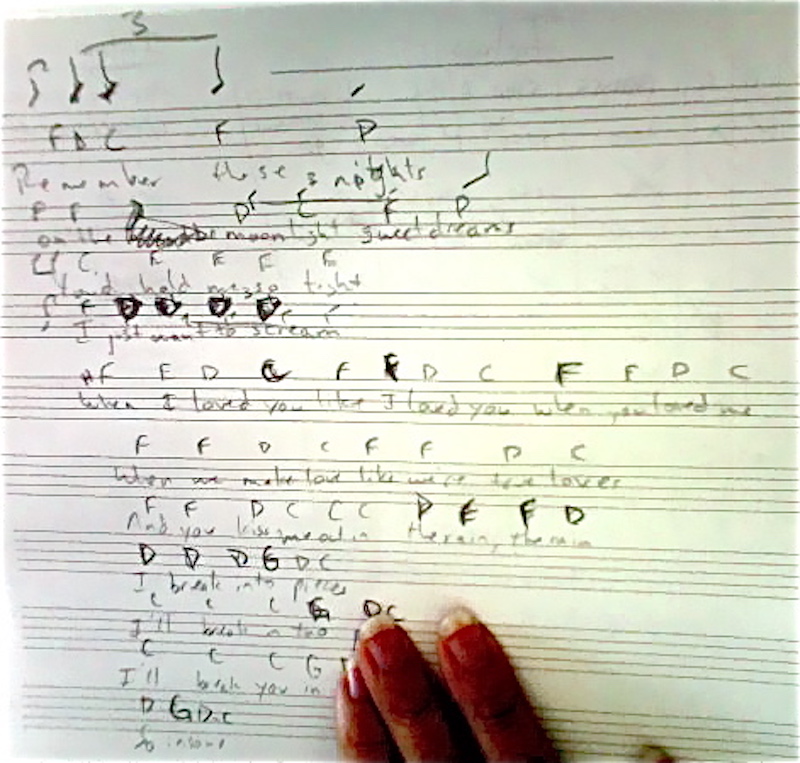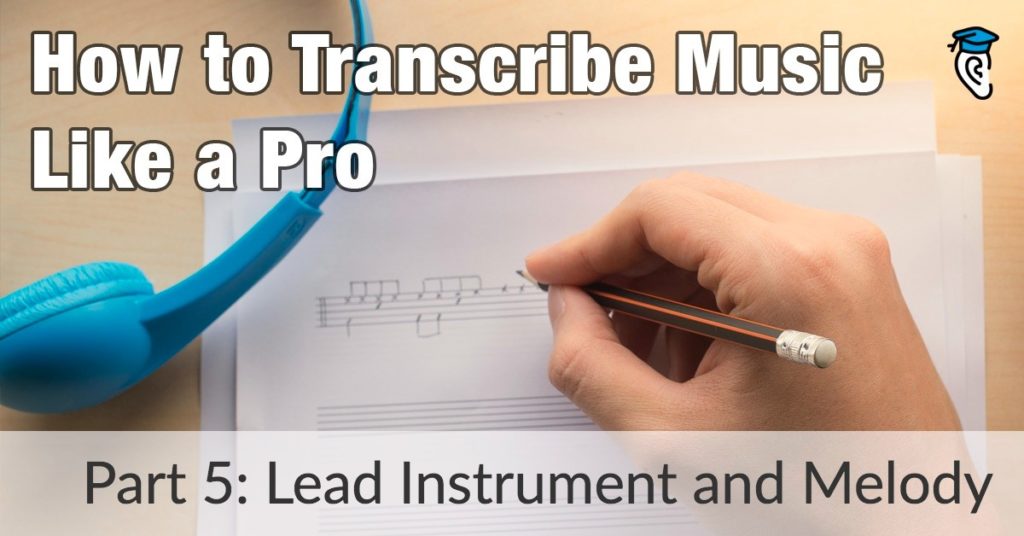When you think about transcribing a music track, you probably think first about the melody played by the lead instrument. This is the part we think of as “the tune” and remember most easily from music we’ve heard. Already in this series we have put in place all the structures and frameworks required to make this final part as easy to transcribe as it is to remember.
Skipped a step? Catch up here:
Transcribing the lead instrument
Some folks approach transcription in a different order, trying to figure out the melody before writing out the drums, rhythm section, and chords. While this may seem like the simplest way to do things, it actually tends to get a little tricky if you aren’t familiar with music arranging, as you try to fit all those other components around the melody. When you build up your transcription as I recommend in this series, each step follows easily from the last. Melody is the final icing on the cake. 
By now you have built up a good transcription: with a basic beat outline and the chords of the rhythm section. Now it’s time to add in the melody.
What is a melody?
The catchiest part of the song, the notes that are stuck in your head after you have heard it on the radio, is the melody. Usually this is the most prominent part sung with lyrics in a pop song but it can be played by any lead instrument.
What is a “lead instrument”?
In a song it would be the lyrics sung by a pop star, in instrumental rock track it could be the incredible fingers-flying lead guitar solo, or even the right-hand part of a rocking solo performance on piano. In jazz ensembles, the lead can be played by several instruments like a trumpet or saxophone in turn, and in the full orchestral setting, often the strings will take the lead.
Our running example has until now been instrumental to simplify the transcription tutorial, helping you to more easily hear the individual parts present. Now we are going to add a vocal part at the end, to help you practice transcribing vocal melody. There is also a simple lead synth part that you can transcribe.
Transcribing the Lyrics
Before you begin a transcription involving vocals, take the easiest first step: figure out the lyrics. Normally the easiest, that is! Unfortunately, not all lyrics are created equal. Some are very easy to figure out, while others can be confusing (that’s putting it kindly!)
Let’s take Nirvana’s “Smells Like Teen Spirit” which I’ll assume you are familiar with but haven’t memorized the lyrics to. Without looking at the lyrics shown in the video, listen to this song a couple of times and try to jot down what you hear. And try not to break your pencil when the growling starts at the chorus. Who sang this, zombies?
Now compare what you wrote to the actual lyrics written out for you in the video. How close were you? If you got totally lost at “albino” and “mosquito”, that’s okay. I think we all were…
Luckily it doesn’t matter much if you get the lyrics exactly right. You just need them as the framework for transcribing the notes of the melody. Fortunately, you can find them quickly with a Google search, the liner notes of a CD or vinyl record., or the band’s website.
In our example there is a combination of lyrics sung clearly and not so clearly. Here is the full example with the vocals in the end.
- Loop the ending with your player
- Write down the lyrics
- Check it against the actual lyrics provided below
What lyrics did you end up with? Check it against the lyrics below:
Remember those nights
On the moonlight. Sweet Dreams.
You’d hold me so tight I just want to scream
When I loved you like I loved you when you loved meWhen we make love like we’re true loves
And you kiss me out in the rain, the rainI break into pieces
I’ll break in two pieces
I’ll break you in piecesSo insane
How did you do? Did the last part trick you with the nearly-identical lyrics? How did the audio effects change the sound of the words?
Figuring Out the Notes
Now that you have the lyrics written out, transcribing the melody notes will be easier.
Now I am a percussionist—when it comes to rhythm, I only have to hear it once. But melody? In music theory classes I was often wrong by one or two notes, sometimes writing out stepwise motion when there was a leap or vice versa.
If you’re like me and you have to have an instrument handy, try this simple method. If you’re an Ear Training Guru, you may be able to combine or skip steps.
- Memorize the melody
- Sing the melody out loud
- Listen for where the melody goes up and down
- Listen for any familiar patterns like arpeggios
- “Pluck out” the melody on an instrument
- Transcribe the melody
- Play back the melody
- Make corrections
You don’t have to, but, the melody is the easiest part of a song to memorize and sing, and you won’t waste time scrubbing the audio over and over in a playback engine.
As a shortcut, try writing out the note name and/or rhythm with a pencil over the lyrics, then transfer the information to the transcription.

Feeling confident? Write directly into your score. Just be sure to use pencil!
Pro Tip: You already know the key of the song and the chords used. These give you a huge transcribing shortcut: most melody notes will be drawn from the scale and chord tones. Transcribe the melody in small sections based on the underlying chords. When trying notes,
- start with the chord notes,
- try other notes from the key, and
- try notes from outside the key.
Much faster!
Check Your Work
You’ll want to check your work against the original recording. Loop one short phrase at a time, then play along on your instrument. First check the notes, then the rhythms.
Here are the lyrics and melody transcribed:
Transcription: Melody and Lyrics
How did you do?
Finishing Touches
There is one final instrument, the synth, that you can add to your transcription.
Then download the full transcription below and compare it to your own. Check the placement of your lyrics with the drums and rhythm section. Did you place the lyrics correctly? Which rhythms are difficult? Which are simple?
Transcription Complete!
In this series you have learned how to transcribe a song like a musical professional. We have talked about finding the key of the song, how to transcribe lyrics and melody, how to write down the drums, and how to figure out musical form and chord progressions. With each of these steps, you have developed valuable musical skills. These skills make you stronger as a musician in many more ways than just being a capable transcriber. Though that will certainly come in handy too!
We’re not done yet… As we wrap up this series we’ll look at some common transcription problems and tips for overcoming them.
Continue your journey of learning to transcribe by continually challenging yourself. How quickly can you jot down a rough lead sheet for a new song? How detailed and accurate can you make your transcription? Push yourself to transcribe new genres and styles to further extend each of your transcription skills song structure, harmony, melody, arrangement.
Giveaway Contest!
As mentioned in the first part of this series, Anytune is a fantastic tool to help you transcribe music more easily.
The team behind this excellent software have kindly provided some prizes to accompany our new series, How to Transcribe Music like a Pro.
- To unlock the Pro features of the Anytune iOS app simply follow along with this series and collect the letters of the special unlock code. Then follow the instructions here to redeem the code.
Your third pair of letters: _ _ _ _ _ _ _ _ R E _ _ _
Look out for the next parts of this series to pick up more letters! - We also have 6 copies of Anytune Mac to give away. For a chance of winning, post a comment on our Facebook page here before the series ends. We’ll pick 6 random entrants to win on August 30th!
Our thanks to Anytune for providing these prizes. And good luck!








